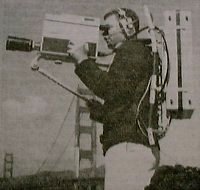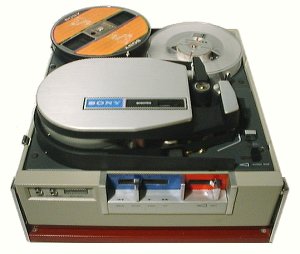Firstly, video is instant - you didn't have to send the tape away to be developed. This was not only fun and convenient, it was vital for covering live events, where re-shooting later is not an option. Secondly, video tape is re-usable, which was particularly attractive to the home-user on a budget as tapes were much more expensive then than they are today. In 1973 a VCR format tape cost over £120 an hour (2002 equivalent), and while things were a bit more realistic by the time Betamax and VHS appeared, tape cost was still an important issue.
Video also needed no special equipment or darkened rooms to be viewed, included sound for no extra cost or complexity, and had automatic exposure and even focus, features which were usually manual on a cine camera.
A professional "portable" system.
Note the chest-brace needed
to support the camera!
Note the chest-brace needed
to support the camera!

